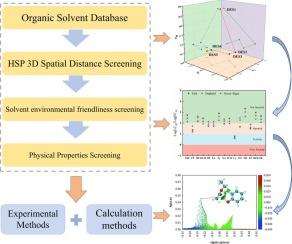Coal tar phenolic DES back-extraction study based on Hansen parameters: A combined experimental and computational approach
IF 7.5
1区 工程技术
Q2 ENERGY & FUELS
引用次数: 0
Abstract
This study developed a high-efficiency screening method based on Hansen Solubility Parameters (HSP) for selecting optimal back-extractants from Phenol-rich phases after Phenol extraction using deep eutectic solvents (DESs). The spatial distance between organic solvents and Phenol in the three-dimensional solubility space was calculated, and diethyl ether (DE) was used as a benchmark for preliminary screening. Further multi-dimensional optimization was performed by integrating ecotoxicity, physical properties (boiling point and viscosity), and environmental impacts (mutagenicity and bioaccumulation), ultimately identifying tetrahydrofuran (THF) and several ester solvents (MF, MA, EA) as potential back-extractants. Experimental verification showed that THF exhibited the best back-extraction performance, and the order of extraction efficiency (THF > MF > EA > MA > DE) was highly consistent with the calculation results of spatial distance and interaction energy. Mechanistic studies revealed that back-extraction efficiency mainly depends on hydrogen bonding interactions and hydrophobic effects between the solvent and Phenol. After 3 cycles of experiments, THF still maintained high regeneration rate of DESs and high extraction rate of phenol, confirming the effectiveness and reliability of this screening method.

基于Hansen参数的煤焦油酚醛DES反萃取研究:实验与计算相结合的方法
本研究建立了一种基于Hansen溶解度参数(HSP)的高效筛选方法,用于深度共晶溶剂(DESs)萃取苯酚后富酚相的最佳反萃取剂筛选。计算有机溶剂与苯酚在三维溶解度空间中的空间距离,以乙醚(DE)为基准进行初步筛选。通过综合生态毒性、物理性质(沸点和粘度)和环境影响(诱变性和生物积累)进行进一步的多维优化,最终确定了四氢呋喃(THF)和几种酯溶剂(MF、MA、EA)作为潜在的反萃取剂。实验验证表明,THF的反提取效果最好,提取效率的排序(THF > MF > EA > MA >; DE)与空间距离和相互作用能的计算结果高度一致。机理研究表明,反萃取效率主要取决于溶剂与苯酚之间的氢键作用和疏水作用。经过3个循环的实验,THF仍然保持了较高的DESs再生率和苯酚提取率,证实了该筛选方法的有效性和可靠性。
本文章由计算机程序翻译,如有差异,请以英文原文为准。
求助全文
约1分钟内获得全文
求助全文
来源期刊

Fuel
工程技术-工程:化工
CiteScore
12.80
自引率
20.30%
发文量
3506
审稿时长
64 days
期刊介绍:
The exploration of energy sources remains a critical matter of study. For the past nine decades, fuel has consistently held the forefront in primary research efforts within the field of energy science. This area of investigation encompasses a wide range of subjects, with a particular emphasis on emerging concerns like environmental factors and pollution.
 求助内容:
求助内容: 应助结果提醒方式:
应助结果提醒方式:


